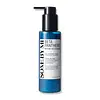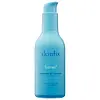What's inside
What's inside
 Key Ingredients
Key Ingredients

 Benefits
Benefits

 Concerns
Concerns

 Ingredients Side-by-side
Ingredients Side-by-side

Water
Skin ConditioningSodium Cocoyl Isethionate
CleansingSodium Methyl Cocoyl Taurate
CleansingGlycerin
HumectantDipropylene Glycol
HumectantCoco-Betaine
CleansingLauryl Hydroxysultaine
CleansingPanthenol
Skin Conditioning1,2-Hexanediol
Skin ConditioningGlyceryl Stearate
EmollientSodium Chloride
MaskingPropylene Glycol Laurate
Skin ConditioningPolyglyceryl-3 Methylglucose Distearate
EmulsifyingGlycol Distearate
EmollientMusa Sapientum Fruit Extract
Skin ConditioningRosa Damascena Flower Water
MaskingPolyquaternium-67
Pyrus Communis Fruit Extract
Skin ConditioningPrunus Domestica Fruit Extract
MoisturisingCitric Acid
BufferingEthylhexylglycerin
Skin ConditioningCucumis Melo Fruit Extract
Skin ConditioningDisodium EDTA
Hedera Helix Leaf/Stem Extract
AntimicrobialGluconolactone
Skin ConditioningSea Water
HumectantPropanediol
SolventSodium Acetate
BufferingArginine
MaskingHydrogenated Lecithin
EmulsifyingSorbitan Olivate
EmulsifyingCetearyl Olivate
Beta-Sitosterol
Emulsion StabilisingLactococcus Ferment Lysate
Skin ConditioningBifida Ferment Lysate
Skin ConditioningLactobacillus Ferment Lysate
Skin ConditioningPhytosterols
Skin ConditioningTocopherol
AntioxidantGlycine
BufferingSerine
MaskingGlutamic Acid
HumectantAspartic Acid
MaskingLeucine
Skin ConditioningAlanine
MaskingLysine
Skin ConditioningTyrosine
MaskingPhenylalanine
MaskingValine
MaskingThreonine
Proline
Skin ConditioningIsoleucine
Skin ConditioningHistidine
HumectantMethionine
Skin ConditioningCysteine
AntioxidantWater, Sodium Cocoyl Isethionate, Sodium Methyl Cocoyl Taurate, Glycerin, Dipropylene Glycol, Coco-Betaine, Lauryl Hydroxysultaine, Panthenol, 1,2-Hexanediol, Glyceryl Stearate, Sodium Chloride, Propylene Glycol Laurate, Polyglyceryl-3 Methylglucose Distearate, Glycol Distearate, Musa Sapientum Fruit Extract, Rosa Damascena Flower Water, Polyquaternium-67, Pyrus Communis Fruit Extract, Prunus Domestica Fruit Extract, Citric Acid, Ethylhexylglycerin, Cucumis Melo Fruit Extract, Disodium EDTA, Hedera Helix Leaf/Stem Extract, Gluconolactone, Sea Water, Propanediol, Sodium Acetate, Arginine, Hydrogenated Lecithin, Sorbitan Olivate, Cetearyl Olivate, Beta-Sitosterol, Lactococcus Ferment Lysate, Bifida Ferment Lysate, Lactobacillus Ferment Lysate, Phytosterols, Tocopherol, Glycine, Serine, Glutamic Acid, Aspartic Acid, Leucine, Alanine, Lysine, Tyrosine, Phenylalanine, Valine, Threonine, Proline, Isoleucine, Histidine, Methionine, Cysteine
Water
Skin ConditioningSodium Methyl Cocoyl Taurate
CleansingCocamidopropyl Hydroxysultaine
CleansingGlycerin
HumectantCaprylyl/Capryl Glucoside
CleansingSodium Cocoyl Isethionate
CleansingGlycol Distearate
EmollientBetaine
HumectantPanthenol
Skin ConditioningChondrus Crispus Extract
Skin ConditioningAloe Barbadensis Leaf Juice
Skin ConditioningGluconolactone
Skin ConditioningSodium Hyaluronate
HumectantJojoba Oil/Macadamia Seed Oil Esters
Skin ConditioningSqualene
EmollientPhytosteryl Macadamiate
Skin ConditioningPhytosterols
Skin ConditioningTocopherol
AntioxidantPropanediol
SolventHydroxypropyl Guar Hydroxypropyltrimonium Chloride
Xanthan Gum
EmulsifyingPolyacrylate Crosspolymer-6
Emulsion StabilisingSodium Chloride
MaskingEthylhexylglycerin
Skin ConditioningCitric Acid
BufferingBenzoic Acid
MaskingPhenethyl Alcohol
MaskingPentylene Glycol
Skin ConditioningTrisodium Ethylenediamine Disuccinate
T-Butyl Alcohol
PerfumingSodium Hydroxide
BufferingSodium Benzoate
MaskingPhenoxyethanol
PreservativeWater, Sodium Methyl Cocoyl Taurate, Cocamidopropyl Hydroxysultaine, Glycerin, Caprylyl/Capryl Glucoside, Sodium Cocoyl Isethionate, Glycol Distearate, Betaine, Panthenol, Chondrus Crispus Extract, Aloe Barbadensis Leaf Juice, Gluconolactone, Sodium Hyaluronate, Jojoba Oil/Macadamia Seed Oil Esters, Squalene, Phytosteryl Macadamiate, Phytosterols, Tocopherol, Propanediol, Hydroxypropyl Guar Hydroxypropyltrimonium Chloride, Xanthan Gum, Polyacrylate Crosspolymer-6, Sodium Chloride, Ethylhexylglycerin, Citric Acid, Benzoic Acid, Phenethyl Alcohol, Pentylene Glycol, Trisodium Ethylenediamine Disuccinate, T-Butyl Alcohol, Sodium Hydroxide, Sodium Benzoate, Phenoxyethanol
 Reviews
Reviews

Ingredients Explained
These ingredients are found in both products.
Ingredients higher up in an ingredient list are typically present in a larger amount.
Citric Acid is an alpha hydroxy acid (AHA) naturally found in citrus fruits like oranges, lemons, and limes.
Like other AHAs, citric acid can exfoliate skin by breaking down the bonds that hold dead skin cells together. This helps reveal smoother and brighter skin underneath.
However, this exfoliating effect only happens at high concentrations (20%) which can be hard to find in cosmetic products.
Due to this, citric acid is usually included in small amounts as a pH adjuster. This helps keep products slightly more acidic and compatible with skin's natural pH.
In skincare formulas, citric acid can:
While it can provide some skin benefits, research shows lactic acid and glycolic acid are generally more effective and less irritating exfoliants.
Most citric acid used in skincare today is made by fermenting sugars (usually from molasses). This synthetic version is identical to the natural citrus form but easier to stabilize and use in formulations.
Read more about some other popular AHA's here:
Learn more about Citric AcidEthylhexylglycerin (we can't pronounce this either) is commonly used as a preservative and skin softener. It is derived from glyceryl.
You might see Ethylhexylglycerin often paired with other preservatives such as phenoxyethanol. Ethylhexylglycerin has been found to increase the effectiveness of these other preservatives.
Gluconolactone is a PHA. PHAs are a great gentle alternative to traditional AHAs.
When applied, Gluconolactone has the same affect on skin as AHAs such as lactic acid. It helps dissolve the dead skin cells in the top layer of your skin. This improves texture and brightens the skin.
PHAs are more gentle than AHAs due to their larger structure. They do not penetrate as deeply as AHAs and take a longer time to dissolve dead cells. Studies show PHAs do not cause as much irritation.
Gluconolactone has some interesting properties:
In a 2004 study, Gluconolactone was found to prevent UV damage in mouse skin cells and has not been found to increase sun sensitivity. However, we still recommend wearing SPF daily.
This ingredient is is an created by reacting gluconic acid with an alcohol.
Learn more about GluconolactoneGlycerin is already naturally found in your skin. It helps moisturize and protect your skin.
A study from 2016 found glycerin to be more effective as a humectant than AHAs and hyaluronic acid.
As a humectant, it helps the skin stay hydrated by pulling moisture to your skin. The low molecular weight of glycerin allows it to pull moisture into the deeper layers of your skin.
Hydrated skin improves your skin barrier; Your skin barrier helps protect against irritants and bacteria.
Glycerin has also been found to have antimicrobial and antiviral properties. Due to these properties, glycerin is often used in wound and burn treatments.
In cosmetics, glycerin is usually derived from plants such as soybean or palm. However, it can also be sourced from animals, such as tallow or animal fat.
This ingredient is organic, colorless, odorless, and non-toxic.
Glycerin is the name for this ingredient in American English. British English uses Glycerol/Glycerine.
Learn more about GlycerinGlycol Distearate serves as a pearlizing or opacifying agent in cosmetic products.
It's often included in cleansers and haircare products to give them a lustrous or shimmering appearance.
It is derived from stearic acid, a natural fatty acid commonly found in vegetable oils and animal fats.
Glycol Distearate isn't fungal acne safe.
Learn more about Glycol DistearatePanthenol is a common ingredient that helps hydrate and soothe the skin. It is found naturally in our skin and hair.
There are two forms of panthenol: D and L.
D-panthenol is also known as dexpanthenol. Most cosmetics use dexpanthenol or a mixture of D and L-panthenol.
Panthenol is famous due to its ability to go deeper into the skin's layers. Using this ingredient has numerous pros (and no cons):
Like hyaluronic acid, panthenol is a humectant. Humectants are able to bind and hold large amounts of water to keep skin hydrated.
This ingredient works well for wound healing. It works by increasing tissue in the wound and helps close open wounds.
Once oxidized, panthenol converts to pantothenic acid. Panthothenic acid is found in all living cells.
This ingredient is also referred to as pro-vitamin B5.
Learn more about PanthenolPhytosterols come from plants, nuts, and whole grains. These compounds have skin soothing and moisturizing properties.
Fun fact: They are similar to cholesterol and can help lower cholesterol levels.
Propanediol is an all-star ingredient. It softens, hydrates, and smooths the skin.
It’s often used to:
Propanediol is not likely to cause sensitivity and considered safe to use. It is derived from corn or petroleum with a clear color and no scent.
Learn more about PropanediolChances are, you eat sodium chloride every day. Sodium Chloride is also known as table salt.
This ingredient has many purposes in skincare: thickener, emulsifier, and exfoliator.
You'll most likely find this ingredient in cleansers where it is used to create a gel-like texture. As an emulsifier, it also prevents ingredients from separating.
There is much debate on whether this ingredient is comedogenic. The short answer - comedogenic ratings don't tell the whole story. Learn more about comegodenic ratings here.
The concensus about this ingredient causing acne seems to be divided. Research is needed to understand if this ingredient does cause acne.
Scrubs may use salt as the primary exfoliating ingredient.
Learn more about Sodium ChlorideSodium cocoyl isethionate is a natural ingredient from coconut oil. It is an ultra gentle cleanser that gives a nice foam without drying the skin or impacting the skin barrier.
The amount of foam created depends on the amount of sodium cocoyl isethionate used in the product.
This ingredient also helps improve the spreadability of a product.
Learn more about Sodium Cocoyl IsethionateThis gentle cleansing and foaming ingredient is known for leaving a smooth feeling in skin and hair. It is made using coconut oil.
According to the manufacturer, it is soluble in water and has resistance to hard water, acid, and alkali.
Due to its coconut base, it may not be Malassezia folliculitis safe.
Learn more about Sodium Methyl Cocoyl TaurateTocopherol (also known as Vitamin E) is a common antioxidant used to help protect the skin from free-radicals and strengthen the skin barrier. It's also fat soluble - this means our skin is great at absorbing it.
Vitamin E also helps keep your natural skin lipids healthy. Your lipid skin barrier naturally consists of lipids, ceramides, and fatty acids. Vitamin E offers extra protection for your skin’s lipid barrier, keeping your skin healthy and nourished.
Another benefit is a bit of UV protection. Vitamin E helps reduce the damage caused by UVB rays. (It should not replace your sunscreen). Combining it with Vitamin C can decrease sunburned cells and hyperpigmentation after UV exposure.
You might have noticed Vitamin E + C often paired together. This is because it is great at stabilizing Vitamin C. Using the two together helps increase the effectiveness of both ingredients.
There are often claims that Vitamin E can reduce/prevent scarring, but these claims haven't been confirmed by scientific research.
Learn more about TocopherolWater. It's the most common cosmetic ingredient of all. You'll usually see it at the top of ingredient lists, meaning that it makes up the largest part of the product.
So why is it so popular? Water most often acts as a solvent - this means that it helps dissolve other ingredients into the formulation.
You'll also recognize water as that liquid we all need to stay alive. If you see this, drink a glass of water. Stay hydrated!
Learn more about Water